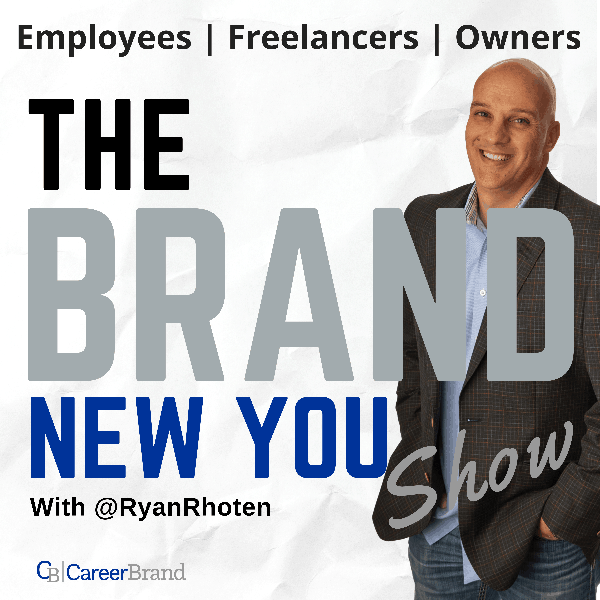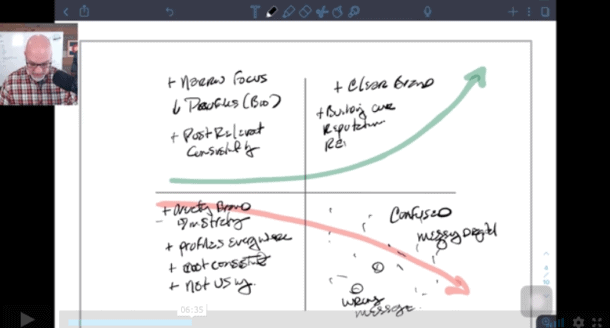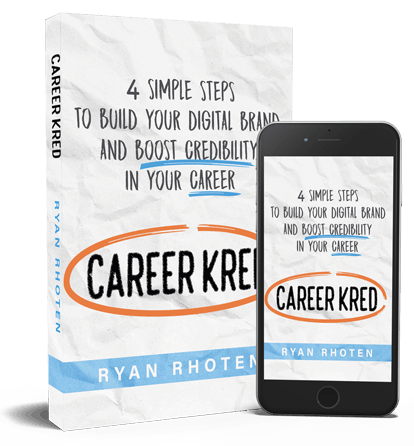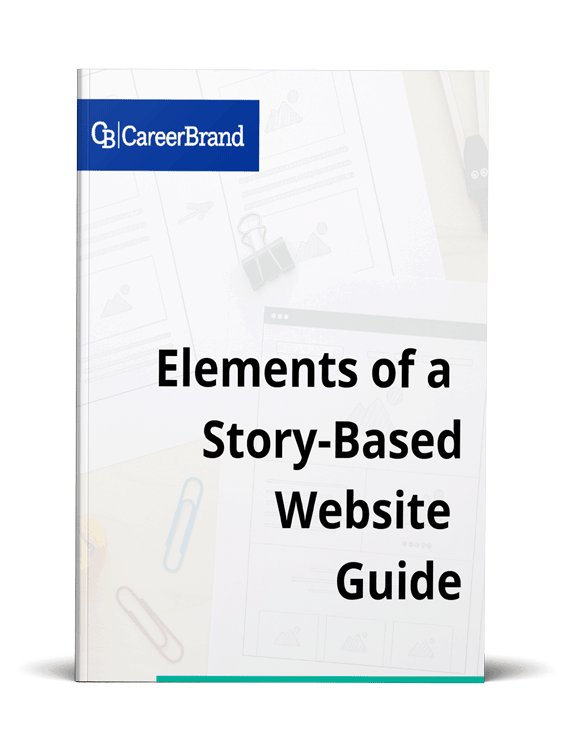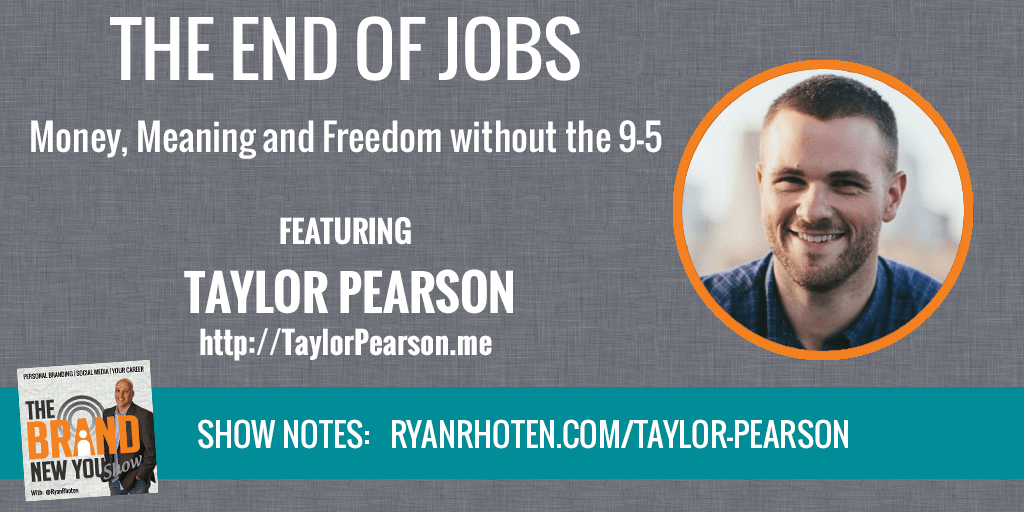
Taylor Pearson is the founder of TaylorPearson.me. He is an entrepreneur and the author of the #1 best-selling book The End of Jobs – Money, Meaning, and freedom without the 9-5.
The End of Jobs was rated by Inc.com as one of the Top Three ‘Start Your Own Business’ Books as well as an overall Top 25 Business Book for 2015.
Taylor believes we’re living through one of the largest socio-economic shifts in human history, the move from the knowledge economy to the entrepreneurial economy. Does this mean we are racing towards the End of Jobs? Find out today.
[smart_track_player url=”http://traffic.libsyn.com/thebrandnewyoushow/Taylor_Pearson.mp3″ title=”Taylor Pearson – The END of Jobs” artist=”Ryan Rhoten” color=”#f5811f” download=”false” social=”true” social_twitter=”true” social_facebook=”true” social_gplus=”true” social_linkedin=”true” social_stumble=”true” social_pinterest=”true” social_email=”true” ]
THE END OF JOBS – MONEY, MEANING, AND FREEDOM WITHOUT THE 9-5
One of the tenants of Taylor's book is we are in the process of shifting between two economies at this moment in time. Specifically, we are moving from the knowledge economy to the entrepreneurial economy.
What does this mean and how does it impact each of us individually, are the key questions I was looking to answer during this interview.
Taylor believes we’ve crossed over what he calls peak jobs. Peak jobs is represented by a period of time when people went to work in large corporations for extended periods of time. He believes these types of jobs, have tailed off and may very well be in their dying days.
Before we got too far down the road, I wanted Taylor to distinguish the differences between a job and entrepreneurship. While the difference may seem obvious to you, Taylor has a unique spin that is worth mentioning.
Here's Taylor's definition of the difference between jobs and entrepreneurship.
A job: You follow a system created by someone else.
Entrepreneurship: You create the system.
If you operate within a system created by someone else, you have a job. If on the other hand, you are the one creating the system, then you are an entrepreneur. This is a definition I can get behind because it makes sense on so many different levels.
THE END OF JOBS BACKGROUND
Why is this important and why does matter? Since 2000, the world's population has grown 2.4% faster than the creation of jobs. Prior to 200, Jobs were growing at a rate of 1.7% faster than population. The world is creating more people than there are jobs available.
While his book is titled the END of Jobs, Taylor is very optimistic about work in the future. He's just not as optimistic about the future of jobs as he defines it.
TayloPearson believes there are 3 primary reasons to believe we are at peak jobs and approaching the end of jobs.
- Communication technology
- Rise of the machines (software/hardware taking over jobs)
- Abundance of credentialization
Communication technology
Advances in communication have made it much easier to find and an infinite amount of information such as specific places to manufacture and develop products.
This used to require a week, an expensive airplane ticket, and hotels. Today this can be accomplished with a quick search on Alibaba or ImportGenius and a Skype call.
Rise of the machines (software/hardware taking over jobs)
The machines referred to here are the advances in software and hardware that is enabling the advancement of things like communications technology. Skype is a great example of software disrupting an old school “technology” and enabling faster decisions
Commoditationzation of credentialization
A sure fire way to differentiate yourself in the corporate world used to be to obtain an advanced degree. The internet has changed this.
The foundation of our education system and specifically our post grad system is based on knowledge being a scarce resource. The intent has turned this once-scarce resource into a commodity, something available to everyone.
During our conversation, Taylor tells us about an example of a person who obtained a degree at MIT who never once stepped foot on campus.
Because knowledge is so readily available, many people all over the world now have the same degrees and just like the economy principle of supply and demand, this has created a glut of credentialization.
Taylor believes in the entrepreneurial economy, it is a much better investment to obtain actual experience vs. going back to school for an MBA. A track record is now the new credential.
GLOBALIZATION AND THE END OF JOBS
You can’t write a book about the end of jobs without addressing the elephant in the room which is globalization.
Taylor sees advancement in communication technology as the primary driver that has aided the rise of globalization.
Communication technology is so interwoven with the commoditization of credentials. How? By making it easier to obtain advanced degrees over the internet. This allows companies to find and source qualified candidates, globally, much easier.
WHAT IS THE LONG TAIL
So while the ability to communicate has increased and software/hardware has played it part in globalization, the internet has enabled the growth of this “thing” Chris Anderson refers to as the long tail.
The long tail is a relatively new phenomena that essentially creates an unlimited amount of new and very niche markets. All enabled by the internet.
Taylor and I walk through an example of the long tail in action and how it is impacting markets every day.
Taylor Pearson believes there are 3 factors impacting the growth of the Long Tail.
Democratization of the Tools of Production
When thinking of production, you might consider an automobile factory or for a book publisher a large distribution warehouse. This requires a big supply chain, logistics, and even trucks.
The barrier to entry was high. To enter the market required a very large outlay of capital to get started. This was difficult for some large companies let alone individuals.
Now through the advent of the internet, improvements in communication technology and the rise of the machines, the tools of production are now accessible to you and me for the very first time for very little initial capital.
Taylor walks us through an example from his experience as a self-published author and an Amazon company called createspace.com
Democratization of Distribution
Distribution channels used to be a very narrow, the Long Tail makes them very broad.
You no longer need to own a supply chain, trucks or expensive equipment to distribute your goods. Thanks to the rise of the machines we can now distribute our own content.
Take media for example. There used to be three channels to get your word out and the vast majority of us had no means of access to this medium. Now we have Youtube, Periscope, Meerkat, Social Media and even podcasts.
All of this is available to us at a fraction of the cost it used to be. The barriers to entry have dropped so low that now anyone can distribute their own media. We are in fact, our own media companies.
The creation of new markets every day
The Internet and the Long Tail also allow for the creation of very specialized niche markets. Taylor gives an example of a shirt designed for tall guys, who like blue and travel a lot.
WHAT IS SAFER -ENTREPRENEURSHIP OR A CORPORATE JOB
With all of this talk about entrepreneurship, Taylor and I discussed whether or not traditional careers are still “safe”.
Taylor looks at this question through the eyes of risk which he defines as the possibility of an irreversible outcome. just because something appears to be stable or lacks change does not mean it is safe.
To explain this further Taylor gives us a story about a turkey and how a Turkeys life, like our jobs, builds up silent risk.
When discussing silent risk, Taylor talks about Max, a real person with a fictions name, and how silent risk adds up over his safe career.
If apply the turkey analogy problem to our careers, you have the culmination of everything Taylor and I discussed up to this point and the reason why you must start considering becoming a brand new you.
HOW DO WE MOVE TOWARDS ENTREPRENEURSHIP
Taylor believes that entrepreneurship is a skill that can be learned. Just like you can learn marketing, accounting or any other discipline.
However to learn it you need to move in that direction. A quick way to do this is a process called the stair-step method.
This process is based on the theory that you slowly move into entrepreneurship by leaning in as Danny Flood stated during our conversion.
The first way to get started is to create a product or do a side project. Both can help you gain experience and additional income.
Your product can be a knowledge-based product. I have said many times that you can indeed sell your knowledge in a product form and this is how you can get started.
The second path is to start a side business using your existing knowledge. If you're a CPA for example, start to consult or take on private clients silent on the side.
In addition to starting something on the side, like David Fisher said during our discussion, changing your circles is critical to making the move to entrepreneurship.
Taylor and I discuss how this principle applies to Max and how his situation could have been different had he spend time building a network.
Another often overlooked route you can take is considering an apprenticeship.
An apprenticeship allows you to gain practical experience by learning from someone who has been in your shoes already or who is doing the role you want to do.
THE HALLWAY TEST
If the thought of entrepreneurship scares you, I suggest you take the hallway test. This is a very simple exercise that any of us can do.
To conduct the hallway test simply lean back in your chair the next time you are at work, look down the hallway at the person who is sitting in the corner office.
Ask yourself, is that the office you want to be sitting in?
If the answer is no, then you need to consider why you answered that way and how you are going to take action to change your path.
TAYLOR PEARSON WRAP
The Best ways to get in touch with Taylor are list below.
Web: taylorpearson.me
Twitter: @taylorpearsonme
email: taylor@taylorpearson.me
Book: Amazon
Download a few chapters: taylorpearson.com/eoj
